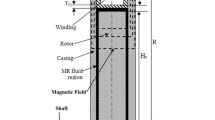Abstract
This study aims to design a magnetorheological (MR) brake with self-protection and heat dissipation functions for elevators. Using permanent magnet system technology, the MR brake can not only form a double magnetic field with excitation coils to improve braking torque under normal operation but also provide braking torque for protection in case of power failure. In addition, a cooling channel is designed in the braking shaft of the MR brake to ensure effective heat dissipation of the MR fluid. In this work, the structure, material, and magnetic circuit of the MR brake is first developed. Then, finite element, magnetic field, and thermal field analyses are conducted on the brake. Finally, a prototype of the brake is produced, and its performance is tested. Results show that the braking torque, especially the self-protection function, meets the demands of the elevator; the increase in temperature during braking is minor; and the noise level is low.
Similar content being viewed by others
References
X. Chen et al., The research of the conductive mechanism and properties of magnetorheological fluids, Physica B Condensed Matter, 418 (6) (2013) 32–35.
W. Zhou, C. M. Chew and G. S. Hong, Development of a compact double-disk magneto-rheological fluid brake, Robotica, 25 (4) (2007) 493–500.
V. A. Neelakantan and G. N. Washington, Modeling and reduction of centrifuging in magnetorheological (MR) transmission clutches for automotive applications, Journal of Intelligent Material Systems & Structures, 16 (16) (2005) 703–711.
S. J. Dyke et al., Modeling and control of magnetorheological dampers for seismic response reduction, Smart Materials & Structures, 5 (5) (1996) 565.
D. H. Wang, H. X. Ai and W. H. Liao, A magnetorheological valve with both annular and radial fluid flow resistance gaps, Smart Materials & Structures, 18 (11) (2009) 115001.
T. Kikuchi, K. Otsuki, J. Furusho, H. Abe, J. Noma and M. Naito, Design and development of compact magnetorheological fluid clutch (CMRFC) with multi-layered disks and micro-sized gaps, Journal of the Society of Rheology, Japan, 38 (1) (2010) 17–22.
X. P. Zheng, Y. F. Guo and S. M. Chen, Magnetorheological technology and its engineering application, Engineering Machinery, 42 (12) (2011) 49–52.
J. Yao and Y. Shi, Development a multi-pole magnetorheological brake, Smart Materials & Structures, 13 (2) (2013) 065008.
W. H. Li and H. Du, Design and experimental evaluation of a magnetorheological brake, International Journal of Advanced Manufacturing Technology, 21 (2003) 508–515.
R. Carlos, J. Adrien, M. Alain and L. Jose, Development of a multilayered wide-ranged torque magnetorheological brake Smart Materials & Structures (2014) 23.
W. H. Li, B. Liu, P. B. Kosaih and X. Z. Zhang, A 2-DOF MR actuator joy stick for assistive keen braces IEEE International Conference on Robotics and Biomimetics (2009) 1883–1888.
J. S. Chen, The structure principle, installation and maintenance of elevator, Beijing: Mechanical industry press, China (2011).
E. Durak and H. A. Yurtseven, Experimental study of the tribological properties of an elevator’s brake linings, Industrial Lubrication and Tribology, 6 (2016) 683–688.
X. P. Zheng, K. F. Chen and S. M. Chen, The research on temperature characteristic of magnetorheological brake in traction elevator, Journal of Chinese Mechanical Engineering, 27 (16) (2016) 2141–2147.
K. D. Meiss and T. G. Duclos, Controllable fluids: The temperature dependence of post-yield properties, International Journal of Modern Physics B, 8 (1994) 3015–3031.
D. Wang et al., Development of a novel two-layer multiplate magnetorheological clutch for high-power applications, Smart Materials & Structures, 22 (8) (2013) 085018.
C. Jędryczka, W. Szeląg and R. M. Wojciechowski, FE analysis of magnetorheological brake with hybrid excitation, International Symposium on Electrodynamic and Mechatronic System, IEEE (2013) 69–70.
D. M. Wang, Y. F. Hou and Z. Z. Tian, A novel hightorque magnetorheological brake with a water cooling method for heat dissipation, Smart Materials & Structures, 22 (2) (2013) 025019.
Z. Z. Tian and Y. F. Hou, A double-disk magnetorheological clutch, CN Patent Application (2011) 201110041597.0.
F. Bucchi et al., A fail-safe magnetorheological clutch excited by permanent magnets for the disengagement of automotive auxiliaries, Journal of Intelligent Material Systems & Structures, 25 (16) (2014) 2102–2114.
J. Y. Chen, Y. K. Shen and X. Z. Chen, The development of pure water cooling system for high power converter, Automation of Electric Power Systems, 12 (2010) 39–42.
Z. Hu, H. Li and G. Wang, Numerical simulation on enhanced heat transfer mechanism and flow characteristics of spiral grooved tubes, The Second China Energy Scientist Forum (2010) 978–1935068-37-2.
J. M. Ginder and L. C. Davis, Shear stresses in magnetorheological fluids: Role of magnetics saturation, Applied Physics Letters, 65 (1994) 3410–3412.
Y. B. Peng, R. Ghanem and J. Li, Investigations of microstructured behaviors of magnetorheological suspensions, Journal of Intelligent Material Systems and Structures, 23 (12) (2012) 1349–1368.
Y. B. Peng and J. Li, Multiscale analysis of stochastic fluctuations of dynamic yield of magnetorheological fluids, International Journal for Multiscale Computational Engineering, 9 (2) (2011) 175–191.
Author information
Authors and Affiliations
Corresponding author
Additional information
Recommended by Associate Editor Cheolung Cheong
Huang Hui received his B.Sc. degree in 2009 and his M.Sc. degree in 2012 from College of Mechanical Engineering and Automation, Fuzhou University, China. Now he is a Ph.D. candidate and experimentalist at Fuzhou University. His main research areas are hydraulic transmission and control, noise and vibration control, and magnetorheological technology and its application.
Shumei Chen is a Professor, Doctoral Supervisor and Vice-Principal of College of Mechanical Engineering, Fuzhou University, Fuzhou, China. She received her Ph.D. in Mechanical Engineering from Beijing Institute of Technology, Beijing, China in 2004 and then continued her post-doctoral research in the Department of Mechanical Engineering, the University of Sheffield, UK. She is the President of Fujian Province Association for Hydraulic and Pneumatic Engineering. Her research interests include control strategy of Magnetorheological/ electrorheological devices, fluid transmission and control, engineering applications of artificial intelligence, etc.
Rights and permissions
About this article
Cite this article
Huang, H., Chen, S. & Chen, K. Novel magnetorheological brake with self-protection and water cooling for elevators. J Mech Sci Technol 32, 1955–1964 (2018). https://doi.org/10.1007/s12206-018-0403-6
Received:
Revised:
Accepted:
Published:
Issue Date:
DOI: https://doi.org/10.1007/s12206-018-0403-6




